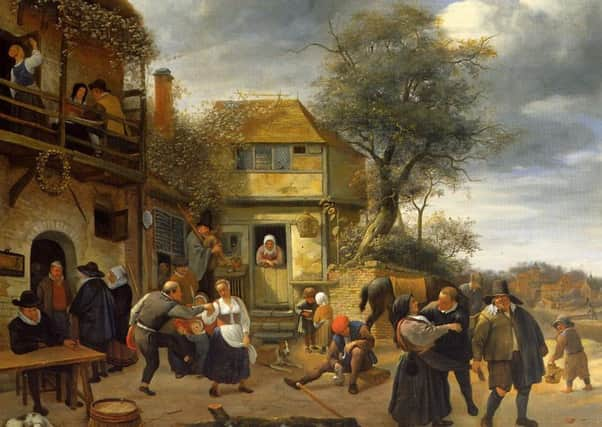Nostalgia: Era when life was all ale and hearty


Hopped beer and unhopped ale were drunk by everyone, anytime, almost everywhere. Alehouses rarely closed. Every public occasion warranted drinking. Weddings, funerals and christenings were invariably accompanied by orgies of drunkenness. Labourers were paid partly in drink. Children and servants were served with “small beer”, a weakened brew. Bargains and contracts were sealed in ale.
Almost every kind of social activity was called an “ale”. At a “scot ale” all shared the costs. There were “ales” throughout the year, at Christmas, Twelfth Night, Plough Monday, Easter, Whitsun, Mayday, Rogation, Lammas, Michaelmas, Martinmas, and many more. The quantities consumed were amazing. Servants in the households of noblemen expected a daily allowance of a gallon of beer, that is eight pints. And the best beer, made with a high proportion of malt barley, was very strong. In Scarborough, the most powerful brew was made for the members and officers of the Common Hall who were elected each year on September 30, St Jerome’s Day and served at the Old Golden Ball on Quay Street. By 1700, unhopped ale, which had to be drunk within three days, had been displaced by hopped beer which lasted longer in the barrel.
Advertisement
Hide AdAdvertisement
Hide AdConsumption of ale and beer was so enormous because water was rightly distrusted and wine was too expensive for all but the rich. Ever since the Assize of Bread and Ale of 1266, the price of ale had been regulated nationally according to the current price of barley, so that it was forbidden to sell ale or beer at more than a penny a quart (two pints) or halfpenny a pint. Also to protect drinkers against short measures, dishonest brewers and irresponsible keepers, at Scarborough there were two “alefyners”, appointed by the Common Hall, to test the quality of brews on the market and examine the measures used by keepers. There were still no accepted national standards so that each locality had its own measures of weight, length and capacity. Scarborough had its own gallon, quart and pint pots. Not even the highest burgesses were allowed to ignore the annual inspections of their “measures”. So, for instance, at the April sessions of 1635, “Misteris Woulfe” was presented “for not bringing in her gallon & aile pinte”. How the alefyners tested the strength of beer is not known, but they were quick to stop overcharging. In 1621, eleven brewers and alehouse keepers, who included two elite burgesses, Nicholas Saunders and Thomas Foord, were brought before the court “for selling ayle above 1d a quart”.
But by the turn of the century there was a government reaction against excessive, public drinking. Between 1604 and 1625 Parliament passed four Acts against what King James I called “the loathsome and odious sin of drunkenness” and alehouse keepers who entertained “lewd and idle people” with their drink. The Act of 1606 allowed magistrates to punish offenders with fines up to five shillings or six hours in the stocks for drunkenness in public. (Needless to say, the King himself was rarely known to be sober).
However, old habits are hard to erase, and magistrates in Scarborough, as elsewhere, were reluctant to penalise anyone other than blatant, persistent offenders. Yet, like all communities, Scarborough had its notorious cases. William Pearson’s insobriety always made him violent; Francis Rogers was barred from all the town’s “aile houses” after several appearances before the court; and Thomas Fell was in trouble because he was found drinking when he should have been at St Mary’s Sunday service.
Scarborians preferred to brew and drink their own. “London bere [or] Sandwith bere or any other bere comyne to the towne by sea” was taxed by order of the Common Hall in 1604 at two shillings and sixpence a firkin (8 or 9 gallons).
Advertisement
Hide AdAdvertisement
Hide AdGiven the volume of consumption and the near exclusion of “foreign ailes”, brewing was one of the town’s main industries. The borough had sometimes as many as 60 licensed brewsters and an unknown number of unlicensed ones who risked legal penalties.
Brewing or selling beer without a licence from the bailiffs, “contrary to the statute”, were some of the most common charges heard in the sheriff’s tourn or court leet. In January 1623, nine unlicensed keepers were caught; in October 1642, seven more were named and fined; and in April 1643, as the Civil War closed in on the town, a record number of 14 brewsters were summoned before the bailifs.
Nevertheless, even after Parliament’s victory in the wars, there was no sustained Puritan campaign against Scarborough’s drinkers. The only exception was Luke Robinson’s year in office as senior bailiff in 1651-2. Almost immediately after election, he issued warrants to the churchwardens and overseers of the poor to report anyone in the town offending against the laws concerning alehouses, tippling, inns and taverns. As a result, 18 men were presented “for tipling in alehouses”, and each fined three shillings and fourpence. As Robinson had instructed, the proceeds went to the overseers of the poor to dole out to paupers. At the same sessions, ten “alehouse keepers entertaining people tipling in there houses” were each fined a swingeing ten shillings each. They included two widows, the town gaoler, a former churchwarden, sub-bailiff and a Royalist ex-soldier.
But the purge did not outlast Robinson. The following year he returned to the House of Commons and his successors granted a record number of brewster licences. Only the new vicar, Edward Carleton, shared Robinson’s extreme prejudice. In 1658, he informed against his own parish clerk after he saw him “stagger in the streets”. Then, two years later, the former Royalist vicar, William Simpson was restored to St Mary’s and his insatiable taste for Canary wine delighted Scarborough’s vintners.